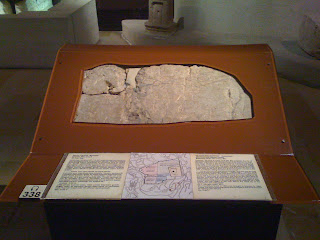I got back to the American Center of Oriental Research in Amman on my flight from Istanbul at 10:30 pm on March 26. I spent the next busy days at ACOR.
I spent my first day back on Tuesday March 27 preparing for my public lecture that evening for the Friends of Archaeology and Heritage about the Archaeology of Early Buddhism in India, in which I spoke in general and presented the results of my survey last December. My talk was followed by extended questions from members of the audience who wanted to know some elementary information about religions in India independent of my talk.
On Wednesday in the afternoon I went downtown to the National Museum at the invitation of Fatimah Maari, a curator there, to see the exhibits. The museum should finally open in a few months. On Thursday I met Hisham Khatib to discuss his forthcoming book about his collection of paintings and books about Jerusalem.
I also started to go through the page proofs of the translation of Gustaf Dalman’s first volume and worked on my report about the marble from the excavations at Humayma.
On Friday I invited my colleague Khader Salameh from Jerusalem to come to ACOR for lunch. He had never been to ACOR before. He had come to attend a conference at the University of Jordan about agriculture in Bilad al-Sham (geographical Syria) in the Islamic periods.
The conference was sponsored by the History of Bilad al-Sham Committee of the University of Jordan, headed by Dr. Adnan al-Bakhit. I was invited to participate, but I declined to present a paper, because I did not really have anything to say about agriculture. I did, however, attend the sessions on the opening day of the conference on Sunday April 1. Two of my former students from the late 1990s at al-Quds University in Jerusalem also attended. My colleague Dino Politis was one of the four participants who gave presentations in English; otherwise all the papers over the four days were in Arabic.
Dino and me at a conference session
Dino, Jean (who has been supporting a women’s cooperative
I spent my first day back on Tuesday March 27 preparing for my public lecture that evening for the Friends of Archaeology and Heritage about the Archaeology of Early Buddhism in India, in which I spoke in general and presented the results of my survey last December. My talk was followed by extended questions from members of the audience who wanted to know some elementary information about religions in India independent of my talk.
On Wednesday in the afternoon I went downtown to the National Museum at the invitation of Fatimah Maari, a curator there, to see the exhibits. The museum should finally open in a few months. On Thursday I met Hisham Khatib to discuss his forthcoming book about his collection of paintings and books about Jerusalem.
I also started to go through the page proofs of the translation of Gustaf Dalman’s first volume and worked on my report about the marble from the excavations at Humayma.
On Friday I invited my colleague Khader Salameh from Jerusalem to come to ACOR for lunch. He had never been to ACOR before. He had come to attend a conference at the University of Jordan about agriculture in Bilad al-Sham (geographical Syria) in the Islamic periods.
The conference was sponsored by the History of Bilad al-Sham Committee of the University of Jordan, headed by Dr. Adnan al-Bakhit. I was invited to participate, but I declined to present a paper, because I did not really have anything to say about agriculture. I did, however, attend the sessions on the opening day of the conference on Sunday April 1. Two of my former students from the late 1990s at al-Quds University in Jerusalem also attended. My colleague Dino Politis was one of the four participants who gave presentations in English; otherwise all the papers over the four days were in Arabic.
Me, Dino and Khader at the conference lunch
Dino and me at a conference session
Dino, Jean (who has been supporting a women’s cooperative
in Ghor al-Safi) and me at the conference dinner.






















